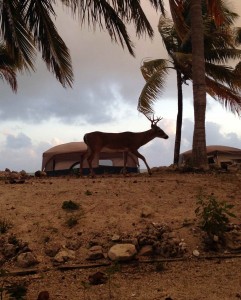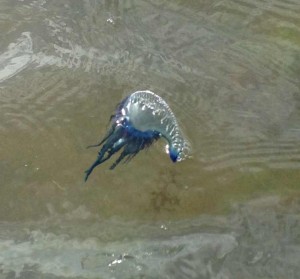Here are the 13 lessons we learned on our extended study to Florida Keys before arriving at the Dolphin Research center (12/28-1/2).
- Flight delays are a very real thing…and when you arrive at the rental car agency at 3 o’clock in the morning, it’s a really mixed bag. You could end up with a white minivan. Or you could end up with a Dodge Charger that can break on a dime. No matter how much you prepare, the airports of America will find you and they will find a way to thwart you. You must be resilient. You must find that strength of will.
- One of the longest bridges in the world is in the keys. Seven Mile Bridge is 35,700 feet long and, at its creation, it was the longest bridge in the world. It is part of the Overseas Highway that stretches across the island chain of the Florida Keys, situated at the southernmost portion of continental US. This famous bridge is featured in Fast and Furious 2 and Mission Impossible III.
- When you see dolphin on the menu, don’t panic. @Alabama Jack’s. It’s actually mahi mahi. Not the kind of dolphins that we will be kissing. ALSO EVERYONE DOWNLOAD THE SEAFOOD WATCH APP (@LACEYWILLIAMS) IT WILL CHANGE THE WORLD. (Note: This app will help you be an informed consumer of humanely caught seafood.)
- Teamwork makes the dream work. How many Colgate students does it take to put up a tent? We still don’t know….But it was a great team-building activity. And we’re very fast at it now. You know what they say… You can give a man a tent and he will sleep for one night, but teach a man to pitch a tent and he will sleep for a lifetime. Another life lesson: Coconuts are nature’s hammer.
- Fresh coconut is delicious. Thanks to our liberal arts education, a healthy dose of curiosity and a little bit of ennui, we learned to utilize tent stakes to extract coconut milk from ripe coconuts. Colgate biology students might be able to sustain themselves after college.
- Every restaurant in the keys has the “best key lime pie”. Obviously, we had to test every one. For science. Shout out to Mangrove Momma’s for our favorite.
- There are a number of forts in the Florida Keys. These were an integral part of the Anaconda Plan, which allowed the union to create a blockade and suppress the confederacy during the American Civil War.
- The Florida Keys are serious about their deer. Seriously. They care more about deer than human pedestrians. There is a special nighttime speed limit to protect the deer, which actually is a really good idea. Key deer are smaller than white tailed deer found in the northeast and are very friendly. They’ll walk up to you and lick your hand if you click your tongue. They’re an endangered subspecies of white-tailed deer that only lives on Big Pine. Their population was as low as 25 at one point but stabilized at 800, so maybe there’s something to be said for those annoying nighttime speed limits

Protected Key Deer walked the beaches at our campsite
- If you arrive at a restaurant in a group of 18, expect to wait. The wait was so long at one restaurant that we were given free minigolf tickets. We are proud of all of our community members, especially Kat, Kait, Zack, Anna and Trevor who all had a hole in one, and Sarah, who really made up for lack of technical skill with enthusiasm.

Cuban Food!!!
- Mangroves smell bad but make up for it by being beautiful and performing valuable ecological services. See our video “An Introduction to Mangroves,” narrated by Madeleine Tsao
- The place to be on New Years Eve is Key West. On the main stretch called Duval street, people from all over the world come to see one of the most unique traditions: the big shoe drop. In the street in front of the Bourbon Street Pub, a lavishly dressed drag queen named Sushi sat in a big red stiletto above the crowd, throwing beads and inciting the crowd to have a great night. Underneath her, the crowd attends live performances of classic covers played by a host of drag queens. It was a sight to see.
- A purple flag at the beach means dangerous marine life is out. AKA a “Portugese Man of War”. These sassy electric blue creatures will sting you if you get too close but are very beautiful. They have a peculiar similarity to inflated plastic bags, and unfortunately many marine animals also confuse the two.

Portuguese Man O’ War Jellyfish
- Fish are friends, not food. And if you swim through their schools above the colorful coral and pretend that you are also a fish they’re pretty happy to adopt you. Coral reefs are the most biodiverse marine ecosystems, holding 1/3 of the worlds marine fish species. Marine life we saw while on our dive/snorkel trip to Looe: manta ray, reef shark, angelfish, parrotfish, barracuda, moray eel, sponges, fan coral, moon jellyfish, comb jellies, Goliath grouper, red fish, blue fish, one fish, two fish. Diver’s rule: if you don’t know what it is, don’t touch it. If you do know what it is, don’t touch it.

Colgate well-represented during dive trip to Looe Key Sanctuary (Elly Hilton, Sarah Anderson, Alex Maulden)
More than anything we learned that the Ingram Filipowicz family is as generous as they are hospitable. We thank them for the wonderful opportunity to participate on this extended study.
Written By: Alex Schaff, Sarah Anderson, Alex Maulden

